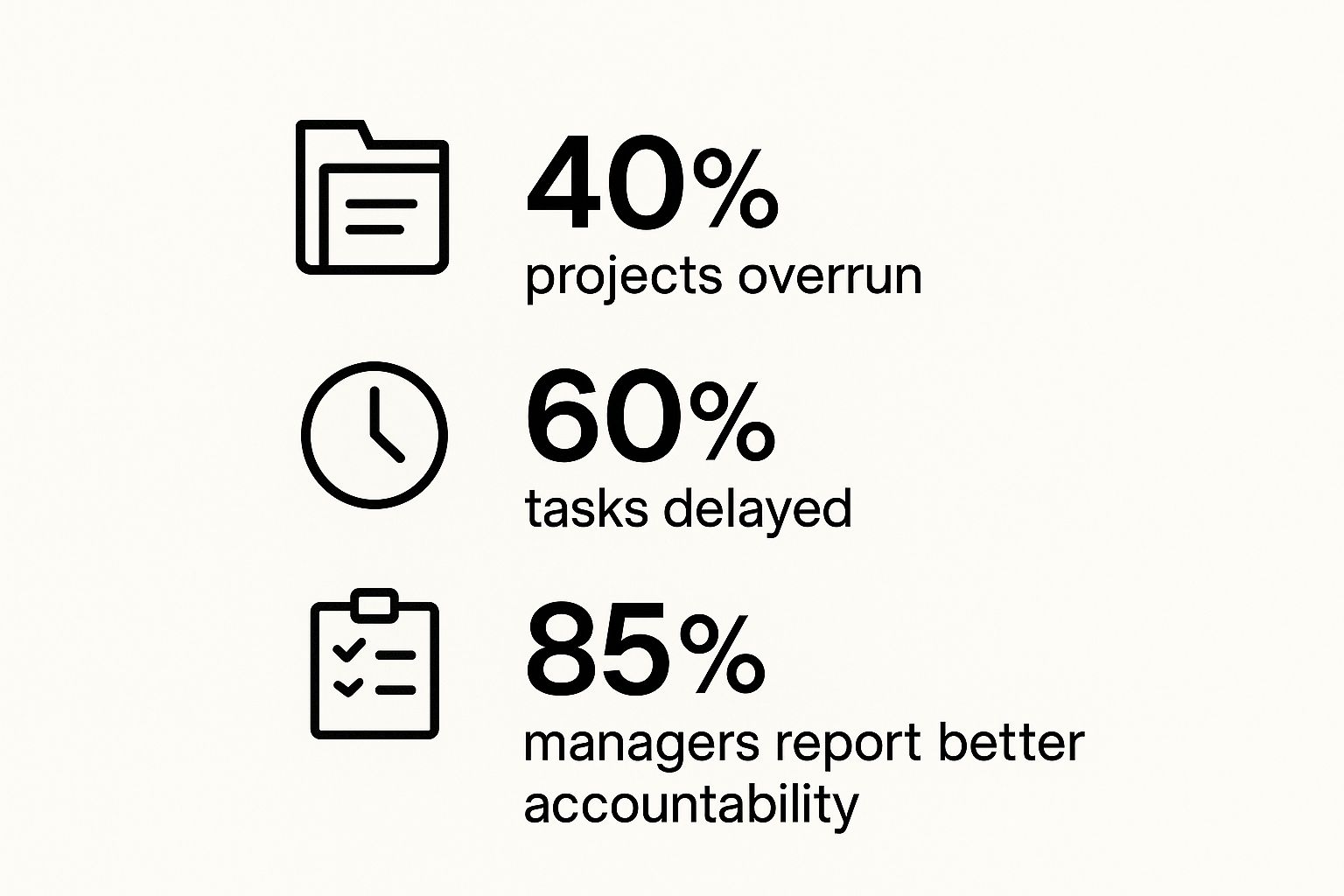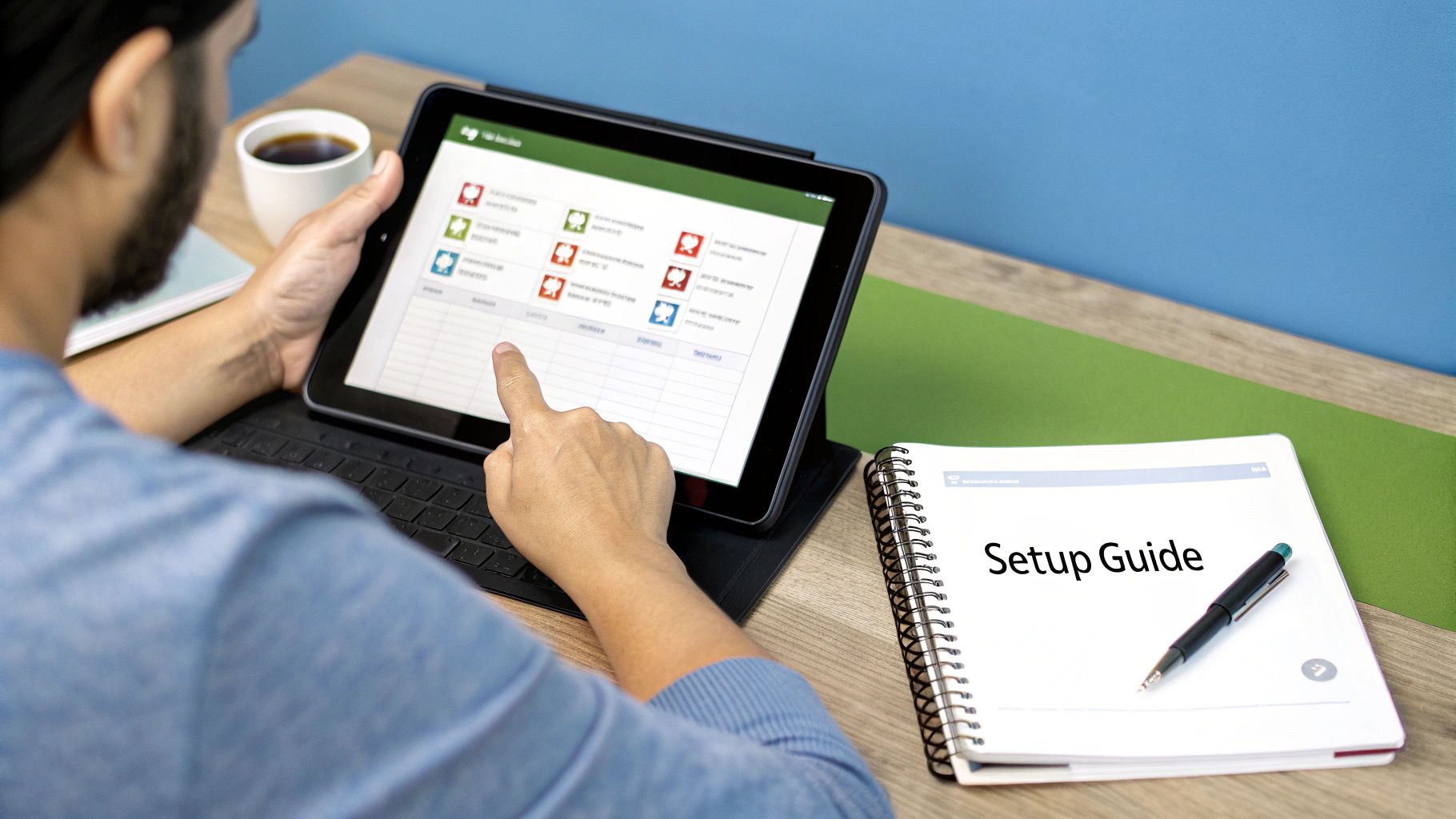If you're still trying to manage projects in a spreadsheet, you know the struggle. The endless manual updates, the mysteriously broken formulas, and the nagging feeling that you never really know where things stand. A real project progress tracker isn't just another tool—it's a fundamental shift that lets you focus on making smart decisions instead of just entering data.
Why Spreadsheets Are Holding Your Team Back
Look, I get it. For a lot of small businesses and creative teams, spreadsheets feel like the default starting point. They're familiar, everyone has them, and they don't cost anything upfront. But that initial convenience quickly turns into a massive headache that kills productivity and creates total confusion. A static grid just wasn't built for the dynamic, fast-moving world of creative projects.
This setup almost guarantees that information gets siloed. Before you know it, people are working off different versions of the "master" file, crucial tasks are slipping through the cracks, and every status meeting feels like a painful exercise in trying to piece together the truth. It's a purely reactive way to work, constantly putting out fires instead of building a smooth, forward-moving workflow.
The True Cost of Manual Tracking
The time you and your team waste on spreadsheet admin is staggering when you actually add it up. Every minute spent manually updating a cell, hunting down a broken formula, or chasing someone for a status update is a minute you're not spending on high-value creative work. It's not just an efficiency problem; it's a morale killer.
This visual really drives home what happens when project tracking falls apart. It's not just about missed deadlines; it's about real, tangible consequences.

When you don't have a solid system in place, accountability goes out the window, and key deliverables end up late. That directly hits your client relationships and your bottom line.
To put it in perspective, let's look at the core differences between wrestling with a spreadsheet and using a purpose-built tool.
Spreadsheet vs Dedicated Tracker: A Quick Comparison
| Feature | Spreadsheet (Manual Tracking) | Dedicated Tracker (Automated System) |
|---|---|---|
| Updates | Requires manual data entry for every change. | Updates in real-time as tasks are completed. |
| Collaboration | Prone to version control issues and data silos. | Centralized hub for all team communication. |
| Visibility | Static view; difficult to see the big picture. | Dynamic dashboards and visual timelines. |
| Integrations | Limited or requires complex, custom scripts. | Seamlessly connects with other tools you use. |
| Scalability | Becomes unwieldy and slow as projects grow. | Designed to scale with your team and complexity. |
The table makes it pretty clear. One is a recipe for chaos, the other a foundation for clarity.
Shifting from Chaos to Clarity
A modern project progress tracker completely changes the game. It acts as the single source of truth—a central hub for everything related to your project. It handles the tedious updates automatically, shows you timelines at a glance, and keeps communication flowing effortlessly.
The whole point is to move from a state of constant catch-up to one of confident control. When everyone knows exactly what they need to do and when, you unlock your team's true potential.
It’s genuinely alarming that even with all the tools available, only 34% of organizations manage to deliver projects on time and on budget. This points to a huge gap between simply having a tool and actually using it to create clarity. The data doesn't lie; teams with a crystal-clear vision of success are often twice as motivated. You can dig deeper into how project management stats reveal these trends and see for yourself.
How to Choose the Right Tracker for Your Team

Jumping into the sea of project management tools can feel completely paralyzing. It's easy to get lost in a whirlwind of feature lists and slick marketing promises. Before you get bogged down, I always tell people to start with one simple question: what are our team’s biggest day-to-day headaches?
That's it. The answer to that question is your north star. A tool that actually solves a real, nagging problem is a tool your team will actually want to use.
Think about it this way. A video production crew constantly wrestling with feedback on different cuts needs a tracker with top-notch proofing and version control. On the flip side, a marketing agency might be more concerned with Gantt charts for campaign timelines and client-facing dashboards for keeping everyone in the loop.
The project management software market is exploding—it was valued at USD 7.36 billion in 2023 and is on track to more than double by 2032. But here's the kicker: only 23% of organizations are using dedicated software, with a shocking number still leaning on spreadsheets. This massive shift is happening because modern teams need more than just a to-do list; they need file sharing, time tracking, and budget management all in one place.
Your Core Decision-Making Checklist
Before you go signing up for a dozen free trials (we've all been there), run through this quick gut-check list. It'll help you weed out the bad fits and zero in on the contenders that truly get how your team works.
- Is it actually intuitive? Seriously, if the user interface requires a manual to figure out the basics, your team will never embrace it. The best trackers just feel right from the moment you log in.
- Does it speak our language? Your tool needs to match your workflow. A design agency needs visual boards and feedback tools built for creatives, while a development team has a completely different set of must-haves.
- Can it play nice with our other tools? A tracker that doesn’t connect with essentials like Slack, Google Drive, or Figma just creates more busywork. Seamless integration isn't a "nice to have"—it's a dealbreaker.
Look, the goal isn't to find the tool with the most features. It's about finding the one with the right features. A simple, well-loved tool is infinitely more powerful than a complex one nobody uses.
Think About Tomorrow, Not Just Today
Finally, think about where your business is headed. A great project progress tracker should grow with you, not hold you back. Ask yourself if the tool you're eyeing can handle more complex projects, larger teams, and whatever new client demands pop up down the road.
This is a huge piece of creative project management, because the needs of a creative team can shift on a dime. For a deeper dive, check out our guide on how to successfully manage creative projects. Picking a scalable tool from the start means you won't have to go through this whole song and dance again in a year.
Tailoring Your Tracker to Creative Workflows

Let's be honest. A generic "To-Do, In-Progress, Done" workflow just doesn't cut it for creative teams. It never has.
The reality of creative work is far messier and more iterative. It needs a project progress tracker that can actually adapt to your unique process, not shove you into some rigid, pre-defined box.
Standard columns always fail to capture those crucial stages where projects get stuck. Think about it—where does a task even go when it's just sitting in "Awaiting Client Feedback" or locked in "Internal Review"? A properly tailored tracker lets you build custom stages that mirror how your team actually gets things done.
This kind of flexibility is what separates a genuinely helpful tool from a frustrating one. Your tracker should fit into your process like a glove, helping you build more effective content creation workflows instead of fighting them.
Build Custom Workflows and Templates
First things first, map out your real-world process. Forget the defaults and create columns that make sense for your team.
A workflow that truly reflects the creative grind might look more like this:
- Briefing & Kickoff: Where the initial project setup and brief approvals happen.
- Drafting & Ideation: The first pass—writing, initial designs, brainstorming.
- Internal Review: Your team's own quality checks and feedback loop.
- Client Feedback: The crucial (and sometimes dreaded) stage for external review and revision requests.
- Final Polish: Where you implement that last round of approved changes.
- Ready for Delivery: The finished asset is signed off on and good to go.
Once you land on a workflow that clicks, save it as a template. This is a massive time-saver for repeatable work like a monthly content calendar or a new client onboarding project. Templates enforce consistency and cut out hours of manual setup, letting you spin up new projects in an instant. For more insights on structuring your work, it’s worth learning how to better manage creative projects with a tailored approach.
Key takeaway: The goal here isn't just to check off tasks. It's to create a living, visual map of your entire creative production line. This shows everyone, at a glance, exactly where projects are and what needs to happen to move them along.
You can add another layer of clarity by using custom fields and tags. Categorize tasks by skillset ("copywriting," "design"), priority level, or even a specific campaign. Suddenly, your tracker becomes a powerful command center for your entire team.
Getting Your Team On Board For Good

Let's be real. A brilliant project tracker is totally worthless if it just sits there gathering digital dust. The hardest part of introducing a new tool isn't the setup—it's convincing your team to actually use it.
You can almost hear the collective sigh. To them, it might just look like another box to tick, another admin task piled on their plate. The trick is to show them it's the solution to their biggest headaches, not the cause of a new one.
Frame it as the cure for endless status meetings. The end of digging through scattered email threads to find out what's going on.
This isn't just a creative agency problem, either. In public sector IT, a staggering 81% of projects blow past their deadlines. The private sector is better, but still sees 52% of projects run late. A solid tracking system is the lifeline that keeps things on schedule, no matter what you're building.
Start With a Pilot Program
Don't try to force a company-wide change overnight. That’s a recipe for disaster.
Instead, pick one team that’s generally open to new ideas or a single, self-contained project to run a pilot test. This gives you a low-stakes sandbox to work out the kinks, get honest feedback, and tweak the setup before you roll it out to everyone.
This approach also helps you find your "tracker champion"—that one person on the team who just gets it. They see the value and become your secret weapon, offering tips and encouragement to their colleagues way more effectively than a mandate from management ever could.
Your goal is to make the tracker feel like an invisible, indispensable part of the daily workflow—less like a chore and more like the tool that finally makes their job easier.
Train People in a Way They’ll Actually Pay Attention
Forget the 50-page PDF manual. Nobody's going to read it. Modern training needs to be quick, practical, and right there when you need it.
- Bite-Sized Videos: Record short screen-shares (think 2-3 minutes, tops) showing how to do one specific thing: create a task, update its status, leave a comment.
- Simple Cheat Sheets: A one-page checklist for common tasks is a lifesaver. Your team can pin it up or keep it on their desktop for a quick glance.
- "Office Hours": Book a recurring 30-minute slot each week where your tracker champion is available to answer questions live. It's informal, helpful, and builds confidence.
And remember, when your team is on top of their projects, your clients feel it too. Better internal tracking almost always leads to better external communication. For more on that, check out our guide to improving client communication best practices.
Once the tracker is embedded in your team’s habits, it stops being a task and becomes a genuine asset for clarity and getting things done.
Using Your Tracker for Deeper Project Insights
Okay, so your tracker is up and running. Great. But now the real work begins. It’s time to stop thinking of it as just a glorified to-do list and start seeing it for what it is: a strategic weapon.
A well-kept project progress tracker does more than just tick off completed tasks. It starts to tell a story. It reveals how your team actually works, uncovering patterns you can use to get smarter and more efficient.
This isn’t about micromanaging. It’s about spotting the invisible roadblocks. Start by looking at where your team’s time is really going. If you notice that the "Client Feedback" stage consistently blows past its deadline, that’s not a failure—it's a signal. It tells you your review process needs a tune-up.
Learning to read the data from your projects is a lot like understanding social media marketing analytics; you’re looking for the story behind the numbers to make better decisions next time.
From Data to Decisions
This is where the magic happens. After a few projects, your tracker becomes a goldmine of historical data on timelines, resources, and roadblocks. You can finally move from pure guesswork to making genuinely informed plans for what's next.
Suddenly, you have real answers to critical questions:
- Who's getting swamped? You can spot team members who are consistently overloaded and redistribute the work before they burn out.
- Are we actually profitable? By tracking hours against the budget, you get a crystal-clear picture of which types of projects make you money and which ones are draining resources.
- Where are we getting stuck? Recurring delays are your roadmap for improvement. Pinpoint those process gaps, fix them, and watch your whole workflow get smoother.
When you start analyzing these trends, you build a smarter, more predictable system for getting things done. You stop just reacting to fires and start preventing them in the first place—a key skill when you learn how to measure project success the right way.
Dashboards are your best friend here. Set up a high-level view for clients and stakeholders. It gives them the quick progress updates they crave without pulling you and your team into endless status meetings.
This keeps everyone in the loop while protecting your team's most valuable asset: their focus. Your tracker transforms from a simple task manager into a central hub for both doing the work and understanding it.
Got Questions About Project Progress Trackers?
Even with the best intentions, I get it—jumping into a new tool can feel like a big step. Let's tackle some of the most common questions I hear from teams just like yours.
A huge one is always project scope creep. What do you do when a client keeps adding "just one more thing" and your timeline goes completely off the rails?
This is where your tracker becomes your best friend. By mapping out every single task and milestone from day one, you’ve created a crystal-clear record of exactly what you agreed to deliver. When a new request pops up, you can literally point to the tracker and show how it falls outside the original plan. It makes having that "we need to adjust the budget or timeline" conversation so much easier.
If you want to really nail this down, our guide on https://creativize.net/blog/controlling-project-scope has some great, practical strategies.
But Won't Managing It Just Waste More Time?
This is another fair question. Is the tracker just going to become another tedious chore on your to-do list?
Here’s the secret: choose a tool that feels intuitive and slot it into how you already work. Don't try to build a whole new process around it. A genuinely good project progress tracker should actually save you a ton of time by getting rid of those endless status meetings and "just checking in" email threads.
For a great breakdown of the core ideas behind effective progress monitoring, you can find some excellent info on Project Progress Tracking.
The whole point is for the tracker to feel like a natural part of your day, not a burden. It should automate updates and give everyone clarity so you can get back to doing the creative work you love.
When it's set up right, a good system will give you back far more time than you ever put into it. Trust me.
Ready to get a real handle on your projects? Creativize connects you with top-tier creative talent and provides the insights you need to manage workflows effectively. Discover the right professionals for your next project at https://creativize.net.

